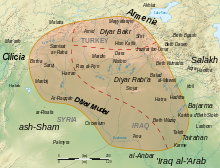User:HistoryofIran/Uzun Hasan
| This is a Wikipedia user page. This is not an encyclopedia article or the talk page for an encyclopedia article. If you find this page on any site other than Wikipedia, you are viewing a mirror site. Be aware that the page may be outdated and that the user in whose space this page is located may have no personal affiliation with any site other than Wikipedia. The original page is located at https://en.wikipedia.org/wiki/User:HistoryofIran/Uzun_Hasan. |
| Uzun Hasan | |
|---|---|
| Shahanshah, Padishah, Sultan | |
| Leader of the Aq Qoyunlu | |
| Reign | 1453–1478 |
| Predecessor | Jahangir |
| Successor | Sultan Khalil |
| Born | 1425 Diyar Bakr |
| Died | January 6, 1478 (aged 54–55) Tabriz |
| Consort | Seljuk Shah Begum Jan Begum Tarjil Begum Despina Khatun |
| Dynasty | Aq Qoyunlu |
| Father | Ali Beg |
| Mother | Sara Khatun |
Abu al-Nasr Hasan Beg ibn Ali ibn Uthman Beg (Persian: ابوالنصر حسن بیگ بن عثمان بیگ, romanized: Abū al-Naṣr Ḥasan Beg ibn ʿAlī ibn ʿUthmān Beg; 1425–1478), better known as Uzun Hasan (اوزون حسن) was the Bayandur leader of the Aq Qoyunlu, ruling from 1453 to 1478. A son of Ali Beg, he ousted his elder brother Jahangir and assumed rule over the Aq Qoyunlu.
Initially ruling in his hereditary home of Diyar Bakr, Uzun vanquished his Kara Koyunlu rivals, and to the east defeated the Timurids, expanding his authority over most of Iran, reigning from 1457 over a vast and strong realm which stretched from eastern Anatolia in the west, to the frontier of Khurasan in the east. With Uzun Hasan's expansion into Iran, he soon adopted Iranian customs for his administration and culture. The Aq Qoyunlu, albeit of Turkic stock, became patrons of Iranian culture, with Uzun Hasan ruling in the style of an Iranian king. This resulted in a brief flowering of culture in the country. The Aq Qoyunlu had in fact adopted the cultural heritage and royal ideology of that of the Timurids.
After returning from an expedition to Tbilisi, Uzun Hasan died from an ilness at Tabriz, on 6 January 1478. He was succeeded by his son Sultan Khalil.
Background[edit]

Uzun Hasan was a member of the Oghuz Turkoman Bayandur tribe, which roamed in the Diyar Bakr region. They had along with other Turkomans migrated to Iran during the era of the Seljuk Empire (1037–1194). Historians believe that the Bayandur later migrated to Anatolia as a result of the Mongol invasions. During the decline of the Mongol Ilkhanate, the Turkoman seized the opportunity to increase their authority in the western and northwestern areas of Iran.[1] By the fall of the Ilkhanate in 1335, the Bayandur roamed the summer pastures in Armenia, in particular the upper reaches of the Tigris river and winter pastures between the towns of Diyarbakır and Euvas.[2] Their clans seemingly united during Timur's invasion of Iran in the second half of the 14th-century, thus forming the Aq Qoyunlu.[1] They bordered other Turkomen confederations, particularly the Kara Koyunlu to the north; the Döḡer to the east; and the Dhu'l-Qadr to the west.[2] The power of the Turkomens increased after the defeat of their rival, the Ottoman sultan Bayezid I (r. 1389–1402), by Timur (r. 1370–1405) at the battle of Ankara in 1402.[1]
Reign[edit]
With the death of Hamza Beg in 1444, his nephew Jahangir (son of Ali Beg) was chosen as the new leader of Aq Qoyunlu.[1][3]
Culture[edit]
Imperial ideology[edit]
Family[edit]
The blood of the Aq Qoyunlu was noticeably mixed. The mother of the early Aq Qoyunlu ruler Uthman Beg (Uzun Hasan's grandfather) was for example a Byzantine princess named Maria of Trebizond.[3]
References[edit]
- ^ a b c d Langaroodi & Negahban 2008.
- ^ a b Quiring-Zoche 1986, pp. 163–168.
- ^ a b Minorsky & Bosworth 1965.
Sources[edit]
- Langaroodi, Reza Rezazadeh; Cooper, John (2008). "Abū Bakr Ṭihrānī". In Madelung, Wilferd; Daftary, Farhad (eds.). Encyclopaedia Islamica Online. Brill Online. ISSN 1875-9831.
- Langaroodi, Reza Rezazadeh; Negahban, Farzin (2008). "Āq-qūyūnlū". In Madelung, Wilferd; Daftary, Farhad (eds.). Encyclopaedia Islamica Online. Brill Online. ISSN 1875-9831.
- Manz, Beatrice Forbes (2007). Power, Politics and Religion in Timurid Iran. Cambridge University Press. ISBN 978-1-139-46284-6.
- Markiewicz, Christopher (2019). The Crisis of Kingship in Late Medieval Islam. Cambridge University Press. ISBN 978-1108492140.
- Minorsky, V. & Bosworth, C.E. (1965). "Uzun Ḥasan". In Lewis, B.; Pellat, Ch. & Schacht, J. (eds.). The Encyclopaedia of Islam, Second Edition. Volume II: C–G. Leiden: E. J. Brill. OCLC 495469475.
- Quiring-Zoche, R. (1986). "Āq Qoyunlū". Encyclopædia Iranica, online edition, Vol. II, Fasc. 2. New York. pp. 163–168.
{{cite encyclopedia}}: CS1 maint: location missing publisher (link) - Roemer, H. R. (1986). "The Turkmen dynasties". In Lockhart, Laurence; Jackson, Peter (eds.). The Cambridge History of Iran, Volume 6: The Timurid and Safavid Periods. Cambridge: Cambridge University Press. ISBN 0-521-20094-6.
- Savory, R. M. (2009). "The Struggle for Supremacy in Persia after the death of Tīmūr". Der Islam. 40. De Gruyter: 35–65. doi:10.1515/islm.1964.40.1.35. S2CID 162340735.
